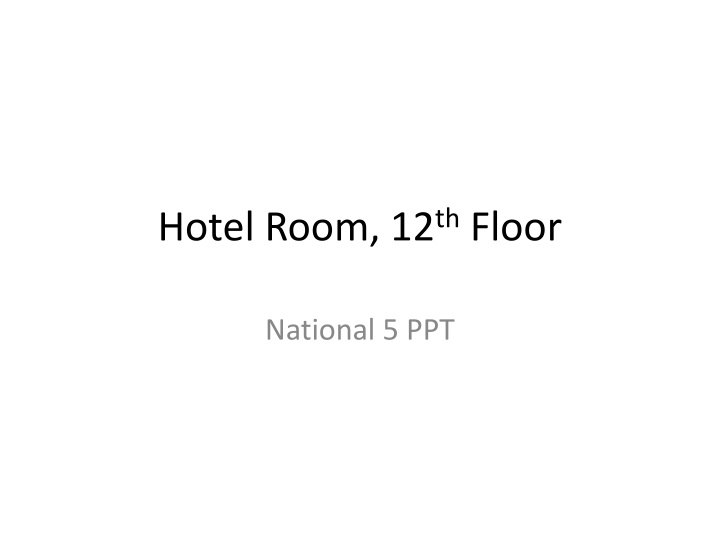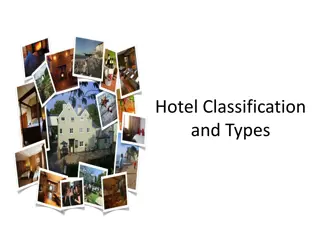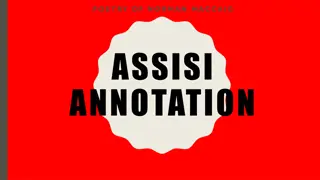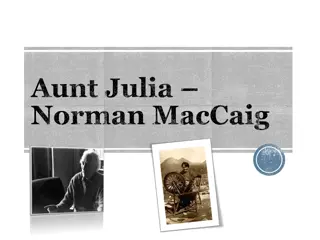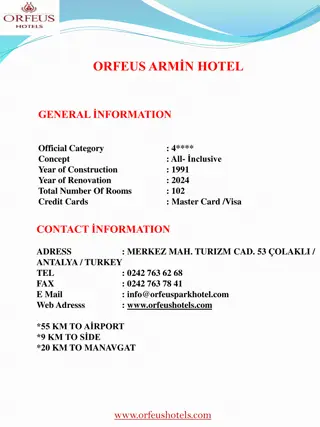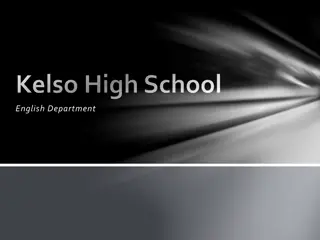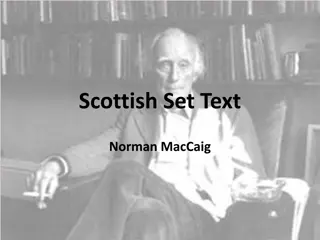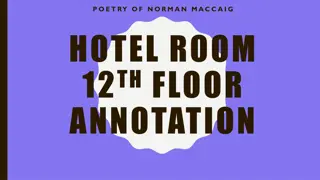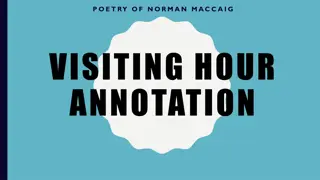Analysis of "Hotel Room, 12th Floor" by MacCaig
An in-depth analysis of the poem "Hotel Room, 12th Floor" by MacCaig, written in 1966. The poem delves into broader questions about humanity, contrasting technological progress with past and present aggression in American society. It explores the balance between light and dark, good and evil, and the theme that evil will always exist despite advances in society. The poem's mood shifts from light-hearted to somber, reflecting on humanity's quest for shelter from darkness. Structured as free-verse, the poem chronicles different parts of the day to offer varied perspectives. The title reflects the transient nature of the speaker's stay and his elevated viewpoint above the city.
Download Presentation

Please find below an Image/Link to download the presentation.
The content on the website is provided AS IS for your information and personal use only. It may not be sold, licensed, or shared on other websites without obtaining consent from the author.If you encounter any issues during the download, it is possible that the publisher has removed the file from their server.
You are allowed to download the files provided on this website for personal or commercial use, subject to the condition that they are used lawfully. All files are the property of their respective owners.
The content on the website is provided AS IS for your information and personal use only. It may not be sold, licensed, or shared on other websites without obtaining consent from the author.
E N D
Presentation Transcript
Hotel Room, 12thFloor National 5 PPT
Context Is an autobiographical poem, written in 1966. It documents a personal experience of MacCaig s like Aunt Julia and Basking Shark . Like both of these poems, it s concerns are not limited to MacCaig he uses the poem, and his own experiences described, to pose broader questions about humanity. Looks at the balance between light and dark, good and evil and humanity s role in a developing today s society. MacCaig makes reference to the technological advances and achievements of modern-day America, such as the Empire State Building and the PanAm skyscraper. However, he also considers the violent past of America (the Wild West), and compares this past aggression to the aggression felt in the country at present. By tracing the thread of violence throughout American history to the present MacCaig suggests that technological progress has not resulted in good society. In this sense, this is a bleak + negative poem that predicts that evil will always exist.
Mood/Atmosphere The poem begins with light-hearted imagery, with the Empire State Building compared to a jumbo size dentist s drill . The mood gradually becomes more serious (sombre) and reflective, with the ominous conclusion that no stockades can keep the midnight out as humans seek shelter from the uncivilised darkness that night brings.
Form/Structure Hotel Room, 12thFloor is written in free-verse (poetry that doesn t have a regular rhyme/rhythm) Free-verse often enabled MacCaig to explore themes without a restrictive, defined structure Hotel Room 12th Floor is a good example of this, as is Visiting Hour . 3 stanzas no rhyming scheme. It takes the reader through chronological parts of the day, starting in the morning, moving to evening at the close of stanza one before exploring night-time in stanza two.
Title: Hotel Room, 12thFloor Hotel Room = He is only staying for a short time, passing through. Not permanent. 12thFloor = he is in an elevated position high above the city. This allows him a different perspective on the city.
Stanza One This morning I watched from here a helicopter skirting like a damaged insect the Empire State Building, that jumbo size dentist s drill, and landing on the roof of the PanAm skyscraper. But now midnight has come in from foreign places. Its uncivilised darkness is shot at by a million lit windows, all ups and acrosses
Sense of time passing. I watched shows he is passive not involved. This morning + from here specific time + location makes feel more realistic. This morning I watched from here a helicopter skirting like a damaged insect the Empire State Building, that Simile Helicopter = symbol of technological advancement Compared to damaged insect connotations of something insignificant, unsteadiness, annoying and broken Word choice skirting is going around in circles like an insect with a broken wing would. It is aimless and broken just like society is. Historical context! The Empire State Building, was the world s tallest building when poem written. It therefore represents America s power and progress.
MacCaig compares iconic landmark tourist attraction + symbol of Americas power and dominance to a machine that connotes fear and pain. Symbolises the suffering of people left behind by progress. Suggests that a building of this size is pointless. He seems to criticise an (American) view that bigger is better . MacCaig also showing his dislike of the appearance of the building. jumbo size dentist s drill, and landing on the roof of the PanAm skyscraper. But now midnight has come in PanAm Pan American Airlines, a major airline that connected America to the rest or the world. Symbolic and iconic power and progress. The skyscraper [imagery/word choice] was their Headquarters in New York connotes freedom and escape. But turning point. No longer morning + TP in atmosphere will become more sinister. come in suggests midnight is not invited, has turned up. Midnight = connotations of darkness, fear, the unknown America s
foreign unfamiliar, unknown, strange, not understood Something that is not understood is seen as being strange and frightening. Links to the extended metaphor of the Wild West Native Americans seen as savages ( uncivilised ) because were not like the settlers. darkness - what cannot be seen is to be feared. Links to a central theme of the constant battle between light and darkness. Suggests a crossword puzzle visual image of a grid of contrasting squares Suggests that the city is a puzzle with no clues. Connotes business/unpredictability within the structure. from foreign places. Its uncivilised darkness is shot at by a million lit windows, all ups and acrosses 1st sign of violence links to extended metaphor of Wild West. Assonance (internal rhyme) of million lit windows adds impact and scale suggests strength in numbers against the dark. Darkness in battle with artificial light, alongside its connotations of life, knowledge and progress. Raises questions about humanity s ability to use its own inventions (electric light in man-made buildings) to combat the inevitable return of night and darkness.
Stanza Two But midnight is not so easily defeated. I lie in bed, between a radio and a television set, and hear the wildest of warwhoops continually ululating through the glittering canyons and gulches police cars and ambulances racing to the broken bones, the harsh screaming from coldwater flats, the blood glazed on sidewalks.
Enjambment not suggests negativity = pessimistic tone. The use of But at the start of the sentence links back to but used as TP in Stanza 1. Continues the image of battle between good and evil. Extended metaphor portrays the violence of the city as a fight in the Wild West. But midnight is not so easily defeated. I lie in bed, between a radio and a television set, and hear Struggle against the darkness is futile. I lie in bed = he is still passive, though now no longer seeing the city outside He is in bed, suggesting he is trying to sleep block out violence? Suggesting we are surrounded by technology. Or could suggest MacCaig trying to use technology to drown out the sounds of violence from the city outside. trying to
The war cries of the Native American warriors charging into battle now suggest a battle of a different kind. wildest connotations of uncivilised, brutal culture Sound techniques alliteration and assonance = flow and rhythm to the line. Suggestion may be hearing warwhoops from a Western film on the T.V. Means Onomatopoeia stereotypical sound that Native Americans would be shown making in a Western film or TV show. It compares these repeated noises with the constant howl of sirens in the city streets. howl/wail repeated the wildest of warwhoops continually ululating through the glittering canyons and gulches police cars and ambulances racing The desert landscape of the Old West has now become the 1960 s New York skyline. Links to the extended metaphor of the Wild West . glittering refers to lights fighting against the darkness The war cries of old are now alarming cries of a modern age sirens racing suggests urgency. still
Timed Papers Timed Scottish Texts paper Wednesday 12th December. You will get 10 minutes to study at beginning of lesson, and 1 hour to complete (will be 45 minutes in exam). You will be allowed to use your annotated poems in the paper that is all. You will do a second timed paper on the final Wednesday of this term 19th December. No notes allowed during this one. For this, you will get 50 minutes.
Synecdoche (when one part substituted for whole) here broken bones = dead bodies/society broken bones emphasises serious level of violence. harsh screaming = fear, grief or panic People reduced to damaged body parts, noises, spilled fluids. Suggests the place of humans in this society has been lost. to the broken bones, the harsh screaming from coldwater flats, the blood glazed on sidewalks. Refers to the less luxurious, basic flats MacCaig makes point not benefitting all Certain elements of society have been left behind in the pursuit of materialism. This impoverished way of living for some then translates to the streets in form of violence. The skyscrapers may be glazed with windows but the sidewalk is glazed with blood. technological advances WC - glazed suggests a lot of blood again draws attention to harsh, painful reality of the modern city after dark
Stanza Three The frontier is never somewhere else. And no stockades can keep the midnight out.
** Stanza made up of two negative sentences, creating a pessimistic tone. Another reference to the extended Wild West metaphor. The Frontier battles between the Native Americans and the settlers were brutal and bloody. Word choice / enjambment never again stresses the negative Word choice of stockades continues the extended metaphor, allowing MacCaig to sum up the central concerns of his poem in the closing lines. The frontier is never somewhere else. And no stockades can keep the midnight out. A frontier = often an artificial construct. In the Wild West, a frontier was often used to describe a border between civilised and uncivilised societies. By saying that the frontier is never somewhere else, MacCaig suggests that what we see as uncivilised is always with us, always a part of us. The suggestion is that the conflict between light and dark, both literal and metaphorical, cannot be avoided. Whatever we do, however many barriers we put up to keep out the darkness, any resistance is futile. WC midnight = pessimistic, negative, frightening.
Enjambment Used throughout the poem. When a sentence runs onto next line with no punctuation at the end of the line. Used to demonstrate the destructive impact of technology as has destroyed structure of the poem.
Context Is an autobiographical poem, written in 1966. It documents a personal experience . He uses the poem, and his own experiences described, to pose broader questions about humanity. Looks at the balance between light and dark, good and evil and humanity s role in a developing today s society. MacCaig makes reference to the technological advances and achievements of modern-day America (the Empire State Building and the PanAm skyscraper). Considers the violent past of America (the Wild West), and compares this past aggression to the aggression felt in the country at present. This is a bleak + negative poem that predicts that evil will always exist.
Form/Structure Hotel Room, 12thFloor is written in free-verse (poetry that doesn t have a regular rhyme/rhythm). Free-verse allows MacCaig to explore themes without a restrictive, defined structure (similar to Visiting Hour). Takes the reader through chronological parts of the day starting in the morning, moving to evening at the close of stanza one, before exploring night-time in stanza two.
Themes Fear Good vs Evil Technology (= destructive) Light vs Dark Place/people Humanity Violence Suffering
Mood/Atmosphere The poem begins with light-hearted imagery. The mood gradually becomes more serious (sombre) and reflective, with the ominous conclusion that there is nothing we can do to keep the darkness out.
Quick Quiz Complete in jotter + get homework out. Write down a brief summary of Hotel Room, 12th Floor. There is an extended metaphor used throughout the poem. What is it? Why is it used/what does it show? I watched from here/ a helicopter skirting like a damaged insect . How does this quotation demonstrate the theme of technology? What is it trying to tell us?
Comparing with other poems Hotel Room, 12th Floor Idea Visiting Hour Aunt Julia Technology is a destructive force. Violence is present everywhere. Observation of People/Place Suffering (of humanity) Fear Tone of despair/pessimism Personal Experience
Key Message By tracing the thread of violence throughout American history to the present, MacCaig suggests that technological progress has not resulted in world which is civil. The fact that he sees the violence everywhere in NYC, suggests that violence is a part of society cannot be taken out/destroyed/kept at bay. In this sense, this is a bleak poem that predicts that evil will always exist as a part of human life.
Timed Paper 5 minutes to revise begin 11:30. Only annotated poems allowed. 1 hour to complete ends 12:30. Some students get extra time so will be working until 12:45. For those in class finished, you will be expected to complete a question paper projected onto the board in silence until the end of the period, whilst they complete their paper.
Textual Analysis 1. Look at Stanza 1. Through reference to at least 2 examples of language, explain how MacCaig develops a criticism of technology. (4 marks) 2. Look at Stanza 2. Refer to at least 2 poetic techniques, and discuss how MacCaig introduces a sinister tone. (2 marks) Mention tone + Quote + Explanation (how does it show it) + Can you talk about word choice? + refer to question.
Textual Analysis 3. Through reference to at least two poetic techniques, discuss how MacCaig demonstrates the theme of violence. (4 marks) 4. How effective is the first stanza as an opening to the poem? (2 marks)
Textual Analysis Through reference to Hotel Room, 12th Floor, and at least one other poem by MacCaig, show how the poet uses the observation of people and/or place to demonstrate the key ideas of the text. (8 marks)
Plan Which poems? What are their main ideas? How do they use observation of people/place to show them?
